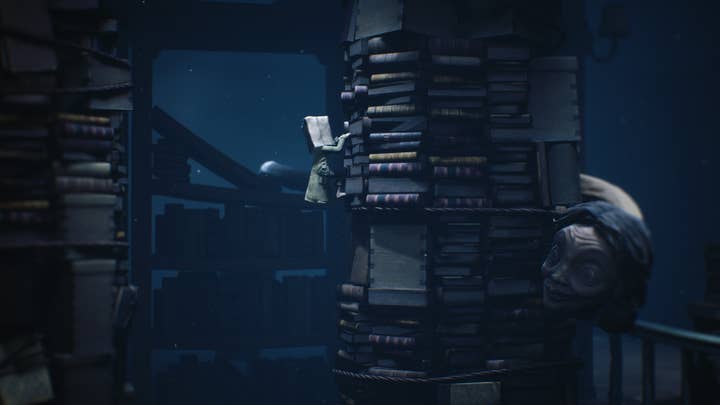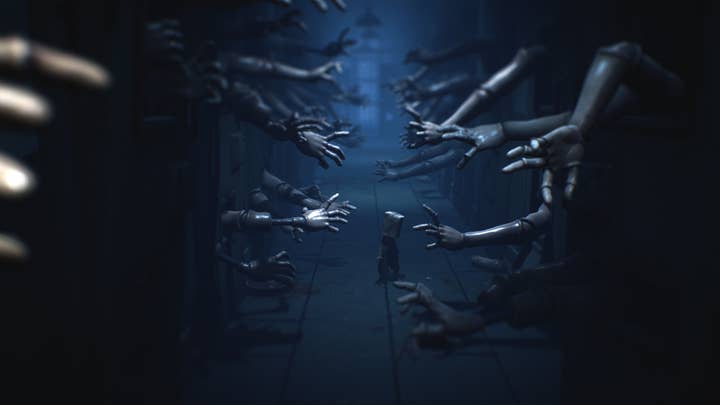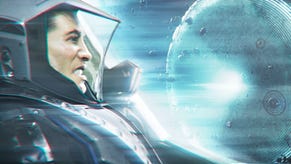Little Nightmares 2 | Critical Consensus
Tarsier Studios' grimly atmospheric sequel is Bandai Namco's biggest critical hit in three years
Among the industry's major publishers, Bandai Namco may be the most inconsistent in terms of the critical reception of its games -- if not across its entire history, then certainly in the last few years.
If you exclude re-releases and remasters of older titles, the last Bandai Namco product to reach a Metacritic average of 80 was Ace Combat 7: Skies Unknown in January 2019. If you narrow that to its more Western-facing games, the track record is patchier still, with its biggest critical success of the last three years being Digixart's 11-11: Memories Retold, which got a Metacritic average of 77 in November 2018.
Both are fine games, of course, but it's fair to say that international publishers with multi-billion dollar revenues aspire to rather more for their high-water marks over such a long period. Indeed, Bandai Namco's recent run of games principally targeted outside of Asia is plainly disappointing: Dontnod's Twin Mirror (60 on PlayStation 4), Supermassive's Dark Pictures: The Little Hope (71), and Slightly Mad's Project Cars 3 (70), and Fast & Furious Crossroads (35). Twelve months, four games, and not a great deal to shout about.
In its way, then, Little Nightmares 2 is something of a statement release for the publisher. With a Metacritic average of 84 on PC, a new Bandai Namco game hasn't received such praise from the critics since Dragon Ball FighterZ when it launched on Xbox One more than three years ago. It may not be a AAA release, exactly, but Tarsier Studios' sequel is generally regarded as both more ambitious and more accomplished than its predecessor, and is a rare critical darling in its publisher's recent portfolio.
"Yes, there really is a 'hand-holding' button -- and it is adorable"
Polygon
According to Polygon's Austen Goslin, many of Little Nightmares 2's abundant pleasures will be familiar to fans of the first game. However, one new feature stands out -- the addition of a new character, Mono, who the player controls while being helped by Six, the protagonist from Little Nightmares. The relationship that forms between Six and Mono, Goslin said, raises the emotional stakes compared to "the total loneliness of the first game."
"Throughout most of the game's levels, Six wanders around with you, assisting in platforming sections to help you reach faraway ledges, leading you in the right direction if you seem stuck, or even just holding your hand as you run through a particularly dark and spooky building. Yes, there really is a 'hand-holding' button -- and it is adorable.
"In some of the game's most stressful, scary, and climactic moments, Six gets separated from Mono, leaving you more alone than you could ever have felt in the original game. Even when I was only separated because she had boosted me up to a ledge we couldn't both reach, levels felt far lonelier and the game's enemies got even creepier."
In several reviews, the central duo in Little Nightmares 2 was compared to the dynamic between the two main characters in Ico -- high praise from games critics, who regard few game directors with more reverence than Fumito Ueda. And if Tarsier was inspired by Team Ico's PlayStation 2 classic, then it likely also drew from the work of Playdead, the celebrated Danish studio that specialises in tightly focused adventure games with masterful control of tone and atmosphere.

"Little Nightmares 2 is the latest in a very specific gaming sub-genre," Jamie Latour said in a review for The Gamer. "Similar to games like Inside and Limbo... this type of game blends together platforming, puzzle-solving, and horror. It also usually features a small child being placed in horrible danger."
In addition to these elements, Playdead's games are also lavishly produced, the brilliant animation, visual aesthetic and sound making its worlds feel entirely believable. The same is true of Little Nightmares 2, Latour continued, reserving particular praise for Tarsier's lighting and audio.
"Seeing the sunlight pouring through the windows in The Hunter's workshop or using the flashlight to illuminate the dark hallways of the abandoned hospital adds so much to the atmosphere. The water, dust, and cloth physics are also top-notch, but the lighting is just on a whole other level.
Latour added: "The ambient sounds of Little Nightmares 2 do a great job in raising the tension. There are cracks and creaks in every dilapidated building, along with the muffled moans of the tortured denizens of the city. When something made of glass shatters, you tense up because you worry that someone might have heard it."
"The ambient sounds of Little Nightmares 2 do a great job in raising the tension"
TheGamer
Not every aspect of the game is so impressive, however. While Tarsier doesn't depart too far from the winning formula it laid out in the first game -- choosing instead to be more ambitious in scope and scale within that familiar structure -- at least one of its new additions left many critics cold. Specifically, in Little Nightmares 2, Mono will occasionally find weapons and wield them to fight enemies
"Being a tiny child, he can only drag it along the floor," said Gamespot's Andrew King. "The scrape of the blade on concrete is pitch-perfect, and the sensation of shifting the weapon's weight to bring it down on an opponent or obstacle feels satisfyingly hefty.
"But there are a few occasions where you're expected to take out multiple enemies in a row without getting hit, and these encounters are more frustrating than fun because of how [slowly] Mono wields weapons. The window for landing a hit is brief, and even though certain enemies take more than one hit to go down, you will always die in a single hit, so you sometimes have to perfectly time several hits in a row or you'll be sent back to a checkpoint."
Where the critics do find fault with Little Nightmares 2, it is in its more typically 'game-y' aspects: the combat, the puzzles, and (perhaps the most common complaint) the platforming. For almost a decade, Tarsier Studios worked with Media Molecule on LittleBigPlanet and almost nothing else, and several reviews highlighted the similarities between Mono and Sackboy in terms of how they control -- a certain physics-based weightiness that also made LBP's platforming an acquired taste.

"The game's big gamble is balancing the horror of surprise against predictable triggers, trial and error and rapid restarts," said Jon Bailes, writing for VGC. "Some risk of failure is essential to keep you alert, but nothing kills fear faster than mechanical repetition.
"For the most part, Tarsier Studios maintains the equilibrium, but its methods are contentious. Just like the first game, the low set camera is perfect to ensure that everything looms. It makes the kids feel doubly stunted against giant buildings that curl forward like stacks of teetering paper, or the bloated mortuary attendant who skitters across ceilings. But it also diminishes your depth of perspective, and makes progress artificially difficult.
"It's often hard to judge exactly how platforms line up, even as shadows and indicative planks try to guide your jumps. You launch the boy heroically towards a ledge, only to flop helplessly to the floor like a cat in a Youtube Fail video. Running down a corridor, you snag for a fatal second on a table leg that you could swear was in the background. It's infuriating."
In almost every case, however, critics who took issue with Little Nightmares 2's underlying mechanics regarded it as a minor problem relative to its strengths as a work of imagination. Ostensibly a horror game, almost every reviewer was full of praise for Tarsier's command of rising tension and disturbing imagery. There are precious few jump scares -- low-hanging fruit in the horror genre -- but the nightmarish visions here linger in the mind for longer than any cheap fright.
"As I mentioned before, there's rarely anything obviously terrible on display, but Tarsier Studios just gets 'fucking horrible' as a concept at an impressively fundamental level," Leon Hurley wrote in a review for GamesRadar+.
"There's a huge darkness to all this despite the childlike presentation. Like when you trap and eliminate a certain character in a furnace, and Six sits down to warm her hands while the screaming is still happening. Another puzzle causes a mindless, disfigured creature that was clearly once human to walk off the top of a building. That's followed by a whole sequence where multiple people step off rooftops as you pass that's pretty disturbing. And, when the game isn't outright trying to mess you up directly, it leaves just enough scattered around the environment to let your mind go to work on the horrible gaps.
"... When Little Nightmares 2 takes the horror gloves off it is *up there* with the best. I would kill to see what Tarsier Studios would do with Silent Hill."







.jpg?width=291&height=164&fit=crop&quality=80&format=jpg&auto=webp)

